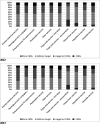Classification of risk for transmission of vaccine-preventable diseases in Brazilian municipalities: comparative analysis before and after the national movement for vaccination and multivaccination proposed by the Ministry of Health as of 2023
- PMID: 39923013
- PMCID: PMC11807307
- DOI: 10.1186/s12889-025-21711-w
Classification of risk for transmission of vaccine-preventable diseases in Brazilian municipalities: comparative analysis before and after the national movement for vaccination and multivaccination proposed by the Ministry of Health as of 2023
Abstract
Objective: To analyze the classification of the risk of transmission of vaccine-preventable diseases in Brazilian municipalities before and after the National Movement for Vaccination and Multivaccination proposed by the Ministry of Health.
Methods: This is an epidemiological, ecological study using secondary data on vaccination coverage, dropout rates, and homogeneity of vaccination coverage (HCV) for ten immunobiologicals recommended for children under 2 years of age. The study aims to compare the years 2022 and 2023 in Brazil. The vaccination coverage index (VCI), HCV, and dropout rate (DR) were evaluated in the municipalities of Brazil in the years 2022 and 2023. The municipalities were classified into risk strata for transmission of vaccine-preventable diseases before and after the strategy proposed by the Ministry of Health.
Results: The study found an increase in median vaccination coverage (VC) for all vaccines evaluated, except for the varicella vaccine. Regarding HCV, in 2022, 27.99% of Brazilian municipalities were classified as adequate (≥ 70%), and 410 (7.36%) achieved 100% HCV for all vaccines. In 2023, 34.90% of municipalities were classified as adequate (≥ 70%), and among them, 582 (10.46%) achieved 100% HCV for all vaccines. In terms of the risk classification for the transmission of vaccine-preventable diseases, Brazil had 72.01% of municipalities classified as high or very high risk in 2022, which decreased to 65.13% in 2023. As for municipalities classified as low or very low risk, 11.27% fell into this category in 2022, increasing to 18.12% in 2023.
Conclusion: The study concludes that VC surveillance, in conjunction with the Microplanning for High-Quality Vaccination Activities methodology developed by the Ministry of Health in 2023, played a crucial role in resuming immunization efforts that had been hindered by science denialism and the COVID-19 pandemic.
Keywords: Monitoring; Risk management; Surveillance; Vaccination coverage; Vaccine-preventable diseases.
© 2025. The Author(s).
Conflict of interest statement
Declarations. Ethics approval and consent to participate: Because it is non -nominal public data, available by Datasus, it was not necessary to approve the study project by a research ethics committee. All procedures performed in studies involving human participants were in compliance with the ethical standards of the institutional research committee, as well as with the 1964 Helsinki declaration and with its later amendments or comparable ethical standards. Consent for publication: Not applicable. Competing interests: The authors declare no competing interests.
Figures
Similar articles
-
Risk classification for the transmission of vaccine-preventable diseases in the state of Minas Gerais, Brazil: 2018 to 2022.PLoS One. 2024 Dec 5;19(12):e0311932. doi: 10.1371/journal.pone.0311932. eCollection 2024. PLoS One. 2024. PMID: 39637119 Free PMC article.
-
Evaluation of the adherence of municipalities and states to the Ministry of Health's microplanning for high-quality vaccination activities and the increase in vaccination coverage in Brazil.BMC Public Health. 2025 Jan 18;25(1):217. doi: 10.1186/s12889-025-21326-1. BMC Public Health. 2025. PMID: 39827108 Free PMC article.
-
[Transmission risk classification for vaccine-preventable diseases in Minas Gerais, Brazil: two years since the onset of the COVID-19 pandemic].Cien Saude Colet. 2023 Mar;28(3):699-710. doi: 10.1590/1413-81232023283.11192022. Epub 2022 Sep 30. Cien Saude Colet. 2023. PMID: 36888855 Portuguese.
-
Risks of low vaccination coverage and strategies to prevent the resurgence of vaccine-preventable diseases in infants in the COVID-19 pandemic scenario: recommendations for Latin America and the Caribbean by the group of experts on infant immunization for Latin America.Expert Rev Vaccines. 2023 Jan-Dec;22(1):1091-1101. doi: 10.1080/14760584.2023.2271057. Epub 2023 Nov 8. Expert Rev Vaccines. 2023. PMID: 37843489 Review.
-
Overview of the United States' Immunization Program.J Infect Dis. 2021 Sep 30;224(12 Suppl 2):S443-S451. doi: 10.1093/infdis/jiab310. J Infect Dis. 2021. PMID: 34590134 Review.
References
-
- Domingues CMAS, Maranhão AGK, Teixeira AM, Fantinato FFS, Domingues RAS. The Brazilian National Immunization Program: 46 years of achievements and challenges. Cad Saude Publica. 2020;36(Suppl 2):e00222919. 10.1590/0102-311X00222919. English, Portuguese. Suppl 2. - PubMed
-
- BRASIL. Plano Nacional de Operacionalização da Vacinação contra a covid-19. Ministério da Saúde, Secretaria Extraordinária de Enfrentamento à COVID-19. 12 ed. Brasília; 2022. Disponível em: https://www.gov.br/saude/pt-br/assuntos/coronavirus/publicacoes-tecnicas.... Acesso em: 7 fev. 2024.
Publication types
MeSH terms
LinkOut - more resources
Full Text Sources
Medical
Research Materials


